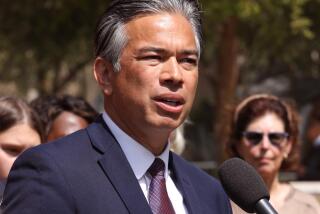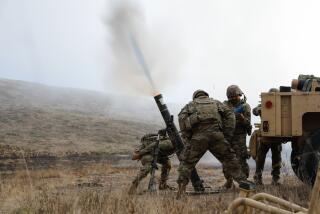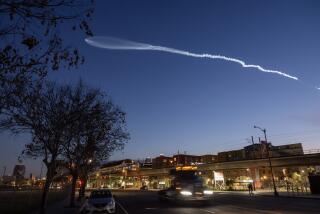Closure Threat Hits Seal Beach Weapons Base
- Share via
SEAL BEACH — The federal base-closure commission stunned the city of Seal Beach on Saturday with news that it had included the city’s 5,000-acre Naval Weapons Station on a list of 60 more sites added for consideration.
The Seal Beach Naval Weapons Station was one of seven California military depots added to the base-closure list as the commission met for 15 hours in Washington into early Saturday.
The weapons station joins dozens of other new Air Force bases, Navy installations and Army facilities that the Defense Base Closure and Realignment Commission has compiled in the past few weeks.
Final recommendations to President Clinton and Congress are due July 1. The commission is due to release its list of options Monday and is expected to decide in June which of the scores of installations should be closed.
One day after Orange County officials held out new hope that the El Toro and Tustin Marine Corps stations might be spared because San Diego’s Miramar Naval Air Station was recommended for possible closure instead, the news of Seal Beach’s addition to the list tempered emotions once more.
“Good Lord!” said Bill Doane, a Seal Beach city councilman who is a strong proponent of the Navy weapons complex. “I would hate to see it closed. The weapons station is a very important part of our defense mechanism.”
In recent months, Seal Beach city and naval officials believed the 49-year-old base would not be included on any closure list, particularly because it is one of only three weapons-loading facilities on the West Coast. The other two are in Concord, Calif., and Bremerton, Wash. The Concord depot, however, is restricted for entry by the Interstae 680 bridge.
Richard Williamson, the public affairs officer for the Seal Beach naval station, said the base employs 1,000 civilians and is responsible for loading ordnance on two-thirds of all the ships in the Pacific Fleet.
In addition, the facility provides assembly and maintenance inspection for standard surface-to-air missiles, he said.
“If they close Seal Beach, it begs the question: Where will ships get their ammunition and maintenance?” Williamson said.
If ships are forced to travel north to Washington, he said, it will take days for the fleet to get there, driving up costs.
The decision to add the Seal Beach Naval Weapons Station came after nearly 15 hours of deliberations late Friday. All told, the commission added three Air Force bases, 25 Navy installations, six Army bases and close to three dozen military depots to the growing list.
Besides the Seal Beach base, six other of the newly listed facilities added late Friday are in California.
Gov. Pete Wilson said Friday that while he was pleased by the decision to add more bases nationwide to the list of potential closures, he criticized the inclusion of even more California installations.
Since the Pentagon first issued its closure list, state officials have complained that California has taken an unfair hit.
After adding numerous Army, Navy and Air Force bases during Friday’s hearing--including the Long Beach Naval Shipyard and the Miramar Naval Air Station in San Diego County--the commission near midnight turned its attention to defense depots, the maintenance facilities that each service branch has developed over the years to meet its own needs.
Since the late 1970s, the Defense Department has been trying to eliminate redundant depots but has been stymied by service parochialism and problems with consolidating the maintenance work into one installation.
The Joint Chiefs of Staff has estimated that the Pentagon could save $2 billion to $9 billion over the next 10 years if unneeded depots are closed.
To help it weigh the Pentagon’s recommendations for closing some of the depots, the commission added more than 20 maintenance facilities at the end of its long day.
Six California depots were added to the commission’s review list besides Seal Beach: North Island Naval Aviation Depot, San Diego; Barstow Defense Distribution Depot; San Diego Naval Depot; the Defense Distribution Depot at McClellan Air Force Base; San Diego Defense Distribution Depot and Barstow Marine Corps Logistics Base.
The new list took the office of Rep. Dana Rohrabacher (R-Long Beach) by surprise.
“I have not seen the weapons station in Seal Beach on any list,” said Kathleen Hollingsworth, the congressman’s district director. “So we have no comment either way.”
The second largest employer in Seal Beach behind Rockwell International Corp., the Naval Weapons Station also provides a major economic boost for the city.
Tom Charara, president of the city’s business association, said a closure would be devastating.
“We have customers from the base come to Main Street on a daily basis, 50 to 100 of them every day,” he said. “It will be a shock for the whole community” if it closes.
Because so many civilian employees also live in the city near where they work, the local housing market is threatened.
“If you take out the families, it takes out a large chunk out of our society,” he said.
Perhaps what city officials and community leaders fear most from a closure is the impact it will have on the 1,000-acre federal wildlife preserve on the land. Should the base be closed, questions would arise about the sanctity of the refuge.
“We are protecting the area for endangered species,” Williamson said. “We want to protect the open space and not see shopping centers on the land.”
To some, the naval base has provided its own safe refuge from expansion and growth that many city residents fear.
“The base is what’s what’s kept Seal Beach’s small-town feel,” said Gordon Shanks, a local community activist. “We are insulated in some ways by the Navy base. If it’s open to housing . . . the personality of Seal Beach would slowly erode.”
Sandra Tolnai, wife of Navy Yeoman 1st Class Michael Tolnai, lives in the base housing on Anchor Way in Seal Beach and feels for the employees and the possibility of lost jobs.
“This will be an economic failure for the Los Angeles area, because the base employs so many civilians,” she said. “The Navy boys like my husband they can ship anywhere. You expect that. But it will be tough on the civilian side.”
She said the Navy has warned its crews since 1989 that the base might close, but there was nothing new lately.
Across the rest of the nation, major installations recommended for closure Friday include: Grand Forks Air Force Base in North Dakota, Fairchild Air Force Base in Washington, and Plattsburgh Air Force Base in New York; the Army’s Ft. Lee and Ft. Monroe in Virginia and the Navy’s Air Training Station and naval hospital at Corpus Christi, Tex.; the Beaufort Naval Hospital in South Carolina; and naval stations at Pascagoula, Miss., Everett, Wash., and Ingleside, Tex.
The original hit list issued by Defense Secretary Les Aspin in mid-March targeted 31 major bases and 122 smaller installations nationwide.
Shortly after the list was announced, the commission added four other bases--two of them in California--bringing the total to 34 major bases facing possible shutdown.
While the additions may be alarming to communities where those bases are located, the changes do not necessarily mean that those bases will close. Two years ago, the commission added 35 bases to its review list, but none were closed.
Times staff writers Jeffrey A. Perlman and Shelby Grad contributed to this report.
More to Read
Sign up for Essential California
The most important California stories and recommendations in your inbox every morning.
You may occasionally receive promotional content from the Los Angeles Times.










